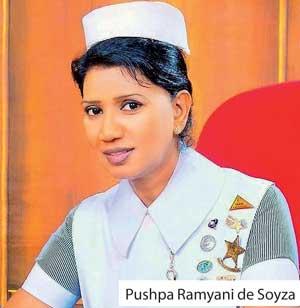03 Nov 2020 - {{hitsCtrl.values.hits}}
 “Our workload is high and it’s extremely stressful,” – this is how Pushpa Ramyani de Soyza, Chief Nurse, National Coordinator (Training) and Triage Team Leader at Accident and Orthopedic Service at the Colombo National Hospital described how all healthcare workers are feeling at present. The already overwhelmed healthcare workforce in Sri Lanka is facing a challenge with the emergence of COVID positive patients along with patients who visit hospitals for other illnesses as well. Every patient is considered a suspected case and the team of healthcare workers continue triaging to ensure that patients are attended to, depending on their clinical urgency. In a candid interview with the Daily Mirror, De Soyza explained the crisis they are facing while pointing out certain areas that the Government could improve in terms of assisting them to continue the fight.
“Our workload is high and it’s extremely stressful,” – this is how Pushpa Ramyani de Soyza, Chief Nurse, National Coordinator (Training) and Triage Team Leader at Accident and Orthopedic Service at the Colombo National Hospital described how all healthcare workers are feeling at present. The already overwhelmed healthcare workforce in Sri Lanka is facing a challenge with the emergence of COVID positive patients along with patients who visit hospitals for other illnesses as well. Every patient is considered a suspected case and the team of healthcare workers continue triaging to ensure that patients are attended to, depending on their clinical urgency. In a candid interview with the Daily Mirror, De Soyza explained the crisis they are facing while pointing out certain areas that the Government could improve in terms of assisting them to continue the fight.
Excerpts :
 Q Were healthcare workers prepared to face the COVID-19 pandemic?
Q Were healthcare workers prepared to face the COVID-19 pandemic?
Diseases aren’t a new thing and in terms of preparedness we were doing alright. The Infectious Diseases Control Unit has given us Personal Protective Equipment and there was a certain level of isolation in wards too. But we were working with a limited staff and had special precautions to take.
Q Were they given a training?
Yes we had time for a pre-training which was conducted by the Ministry of Health. They trained hospitals as well as different units.
Q How difficult has it been to cope up with the crisis?
The healthcare workers cadre is already overwhelmed even without a pandemic. When patients come in, a proper triaging has to take place. Here we have to take all details of patients. The workers are wearing PPEs and they need to be changed. For a long time we didn’t have any issue with the staff, but now since many of them are in quarantine curfew areas they are unable to report to duty. They are not provided with transport and it is a big challenge right now. Workers are stressed. We consider every patient as a suspect, even a dead body. Emergency units are at high risk because not even the minor staffer is reporting for duty. The workers have to work round the clock. If an emergency roster could be designed, then even if one of our workers test positive for the virus, there are negative people who can report to work.
 Q Let’s talk about the triaging system.
Q Let’s talk about the triaging system.
Our triaging method is quite successful. Here we check the medical history of every patient. Since cases are emerging from the community we may miss out on a patient or two, but even the public should act responsibly in this situation. We have to keep a tab on terminally ill patients, cancer patients, patients undergoing kidney transplants and so on.
Q How many patients do they have to attend to for a day?
If I take my Unit, which is the Accident Service, one nurse has to attend to around 1000-2000 people per day. Because it is not only patients that come in, there are other visitors as well. According to international standards, a nurse is expected to attend to somewhere between three and five patients. But with the existing cadre in Sri Lanka it is a bit difficult. We have only 35,000 nurses islandwide. It is the nurse who ultimately has to stay with a patient. Therefore there has to be a coordinated approach to get the entire cadre together. If you take global statistics, out of a 43.5 million healthcare workforce, around 20 million constitute nurses. Hence they are acknowledged as the backbone of the healthcare system. According to the International Council of Nurses, nursing is one of the most dangerous profession in the world.
Q Isn’t there a way to expand the healthcare workforce or recruit new staff?
Nurses go on pension in batches. This is one of the reasons why the cadre is less. They are not recruited annually. But if this cadre was retained it would have been quite helpful during this crisis. Therefore I hope the Government and the authorities would take necessary steps in future to curb the healthcare workers’ crisis.
Q Have you seen a rise in cases of violence, domestic violence and other forms of harassment during this period?
We observe a reduction in these cases. Usually there were around seven men and five women who would be admitted for cases of domestic violence. But the numbers have reduced. We see a 50% reduction in accidents as well.
Q What is the biggest challenge you’re facing right now?
Our workload is high and it’s stressful.
09 Jan 2025 5 hours ago
09 Jan 2025 6 hours ago
09 Jan 2025 9 hours ago
09 Jan 2025 9 hours ago
09 Jan 2025 09 Jan 2025